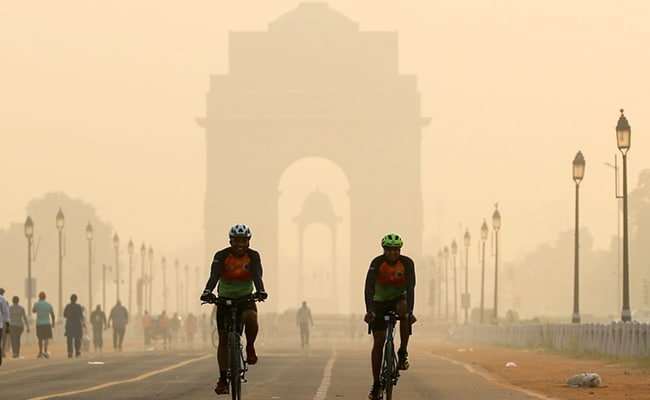[ad_1]

India’s worsening smog has been called out by global cricket stars as they compete in suffocating conditions during the men’s world cup, highlighting the country’s noxious air ahead of its bid to host the Olympic Games.
Several large cities which are hosting World Cup matches in the past few weeks – continue to see “unhealthy” to “very unhealthy” air quality levels, according to monitoring firm IQAir. New Delhi, Mumbai and Kolkata are currently among the world’s top 10 cities in air pollution.
Ahead of their match on Monday in New Delhi, Bangladesh and Sri Lanka canceled a training session over the weekend on the advice of doctors. Some players with asthma stayed at their hotel. The game went ahead even though the capital was ranked the world’s most polluted major city last week by IQAir.
While India has suffered from deadly air quality for years, especially in New Delhi, the images of cricketers slogging it out in this year’s toxic haze is being broadcast at a critical time. Prime Minister Narendra Modi is gearing up to lure the Olympics for the first time to the country in 2036 to bolster the country’s stature much like the Beijing games did for China in 2008.
Last week, cricket captain Rohit Sharma expressed shock at pollution levels in his home town of Mumbai while speaking at a press conference. He said it was “not ideal” before a game against Sri Lanka, while voicing wider concern for the country’s children.
The intervention by such an “influential figure” like Sharma is particularly significant and may help change Indian attitudes toward the country’s deadly air, said Karthik Ganesan, a director at the New Delhi-based Council on Energy, Environment and Water research institute.
England’s Ben Stokes was seen huffing from an inhaler during a training session in the southern tech hub of Bengaluru last month.
‘Eating Air’
Stokes’s team mate Joe Root said playing in Mumbai was like “eating air.”
“It just felt like you couldn’t get your breath,” Root told reporters a week after his team was trounced by South Africa in the city. “It was unique.”
The global and local governing bodies – the International Cricket Council and the Board of Control for Cricket in India – didn’t immediately respond to requests for comment.
While some people have been “kind of dismissive of it” in the past, “clearly over time there has been a change in their attitude to air pollution,” Ganesan said.
Each year, the areas surrounding Delhi are swathed in dirty smog as farmers begin to burn their fields in October and November to quickly clear away rice stubble ahead of wheat planting. The region’s cooler air and a lack of rain helps trap in those fresh pollutants with existing emissions.
Crop Burning
The Supreme Court on Tuesday asked five state governments to immediately stop crop burning, look for alternatives to this practice and start operating smog towers in Delhi.
New Delhi’s authorities have shuttered schools and sporadically deployed water cannons to try to clean the air, but these actions haven’t curbed the root causes of air pollution.
Mumbai, which was usually spared the worst of the country’s toxicity thanks to its coast line, has also witnessed rocketing pollution levels for the past couple of years. Its sky scrapers have been shrouded in recent weeks with smog from traffic fumes and rampant, under-regulated construction.
The deteriorating conditions prompted India’s cricket board to ban traditional firework displays in the two cities following world cup matches.
The pollution is just the latest headache for the BCCI. It faced criticism for shoddy planning right in the opening of the world cup, with ticketing chaos and last-minute schedule changes prompting outcry from fans trying to attend hotly anticipated matches – including the India-Pakistan game last month.
Patchy Record
India’s record in hosting large-scale sporting events has been patchy so far, underscoring the various hurdles it needs to surmount before winning the bid to host the Olympics.
The 2010 Commonwealth Games held in New Delhi was beset by graft scandals and poorly constructed facilities. India’s rowdy democracy also makes it more difficult to act cohesively on multi-pronged problems such as pollution compared to China.
Its clout and monetary power over games like hockey and cricket allow concerns like smog to be overruled in domestically hosted competitions, said Sharda Ugra, a senior Indian sports journalist.
But these can’t be swept aside for an event of stature that the Olympics represents.
This “could be a fantastic impetus for India to showcase how it can turn around a system,” much like China did during the run up to the 2008 Beijing Olympic games, according to Ganesan.
“2036 is still 13 years away,” he said. “We have no idea what climate change is going to bring upon us and what a summer in India will look like.”
(Except for the headline, this story has not been edited by NDTV staff and is published from a syndicated feed.)
[ad_2]
NDTV
